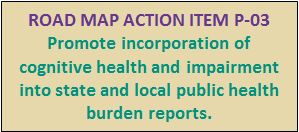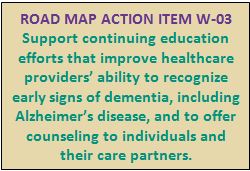| GSA Report Urges Early Detection Efforts by Primary Care Physicians
 Too few seniors are being assessed for cognitive impairment during routine visits with their primary care providers (PCP), according to a new report by the Gerontological Society of America (GSA). The report details action steps to address this shortcoming, noting that increased detection is associated with earlier and more accurate diagnosis, increased access to community supports and services, and improvements in the overall health and well-being of people with cognitive impairment and their families. Too few seniors are being assessed for cognitive impairment during routine visits with their primary care providers (PCP), according to a new report by the Gerontological Society of America (GSA). The report details action steps to address this shortcoming, noting that increased detection is associated with earlier and more accurate diagnosis, increased access to community supports and services, and improvements in the overall health and well-being of people with cognitive impairment and their families.
 Written by a workgroup of experts spanning the public, private, and academic sectors, the report urges primary care providers to assess cognitive health issues during the Medicare Annual Wellness Visit (AWV). The workgroup encourages providers to first utilize the AWV to engage beneficiaries in concerns about cognitive health and, when indicated, subsequently assess for symptoms of impaired thinking, conduct a full diagnostic workup, and refer to appropriate community resources and clinical trials. Written by a workgroup of experts spanning the public, private, and academic sectors, the report urges primary care providers to assess cognitive health issues during the Medicare Annual Wellness Visit (AWV). The workgroup encourages providers to first utilize the AWV to engage beneficiaries in concerns about cognitive health and, when indicated, subsequently assess for symptoms of impaired thinking, conduct a full diagnostic workup, and refer to appropriate community resources and clinical trials.
Public health officials have a key role to play in this effort. As outlined in the Public Health Road Map – jointly developed by the Centers for Disease Control and Prevention (CDC) and the Alzheimer’s Association – the public health community can educate health care providers about validated cognitive assessment tools (action item W-06).
Alzheimer’s Costs to Top $1 Trillion by 2050
 The costs of caring for those with Alzheimer’s disease and other dementias is set to skyrocket to over $1.1 trillion annually by 2050 if a treatment is not found, according to a new report by the Alzheimer’s Association. Changing the Trajectory of Alzheimer’s Disease: How a Treatment by 2025 Saves Lives and Dollars examines the economic toll of Alzheimer’s disease under current conditions as well as what would happen if a hypothetical treatment becomes available that delays onset of the disease by an average of five years. The costs of caring for those with Alzheimer’s disease and other dementias is set to skyrocket to over $1.1 trillion annually by 2050 if a treatment is not found, according to a new report by the Alzheimer’s Association. Changing the Trajectory of Alzheimer’s Disease: How a Treatment by 2025 Saves Lives and Dollars examines the economic toll of Alzheimer’s disease under current conditions as well as what would happen if a hypothetical treatment becomes available that delays onset of the disease by an average of five years.
The report, based on a model developed by The Lewin Group, indicates that if the current trajectory continues, by 2050, 13.5 million Americans will be living with Alzheimer’s disease, with Medicaid and Medicare expected to pay nearly 70 percent of the costs of their care. An
 estimated 6.5 million people would be living in the most severe stage of the disease in 2050; this is more than the total number of Americans with Alzheimer’s in 2015, which would place a tremendous burden on the health and long-term care systems. estimated 6.5 million people would be living in the most severe stage of the disease in 2050; this is more than the total number of Americans with Alzheimer’s in 2015, which would place a tremendous burden on the health and long-term care systems.
If, however, a treatment that delays onset is discovered by 2025 – the goal set by the National Plan to Address Alzheimer’s Disease – only 7.8 million Americans would live with the disease, nearly 42 percent less than would be expected. Furthermore, that treatment would save the United States $367 billion in 2050 alone.
By incorporating these updated prevalence and economic projections into state and local burden reports (Road Map action item P-03), public health officials can encourage communities and policy makers to comprehensively and strategically address the growing Alzheimer’s epidemic.
Depression, Behavioral Changes May Precede Alzheimer’s Disease
 Depression, behavioral changes, and sleep disturbances may be early indicators of – or possibly risk factors for – later cognitive problems, according to new research. Following nearly 2,400 cognitively normal individuals aged 50 and older over an average of Depression, behavioral changes, and sleep disturbances may be early indicators of – or possibly risk factors for – later cognitive problems, according to new research. Following nearly 2,400 cognitively normal individuals aged 50 and older over an average of
seven years, researchers found those who developed impaired thinking patterns indicative of dementia had experienced non-cognitive issues such as depression, anxiety, apathy, changes in appetite, and troubled sleeping more than two times earlier than those who did not experience cognitive impairment.

Because brain changes associated with Alzheimer’s can be present for years before the hallmark indicators of memory loss and impaired thinking develop, identifying early signs and symptoms of potential dementia – such as those in this study – may help enhance early detection while improving the quality of life for both those living with the disease and their caregivers. The Road Map encourages the public health community to support continuing education efforts for health professionals on early detection (action item W-03).
The Alzheimer’s Public Health E-News is supported by Cooperative
Agreement #5U58DP002945-05 from the Centers for Disease Control and Prevention
(CDC). Its contents are solely the responsibility of the Alzheimer’s
Association and do not necessarily represent the official views of the CDC.
For subscription services or to view previous issues of Alzheimer’s Public Health News, please visit http://alz.org/publichealth/public-health-news.asp or contact John Shean (jshean@alz.org).
|